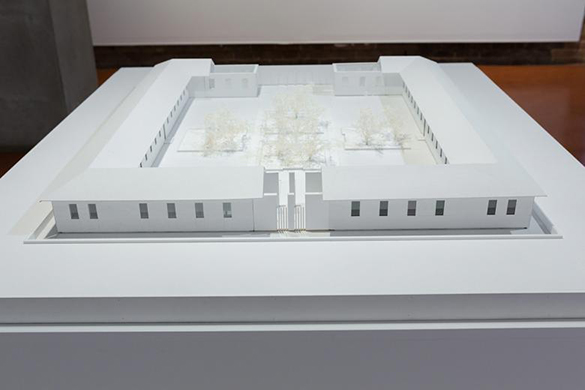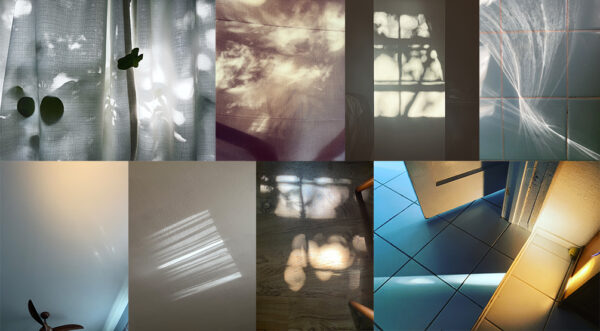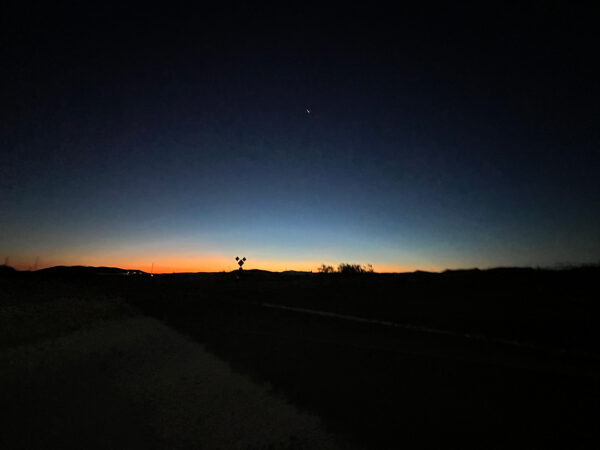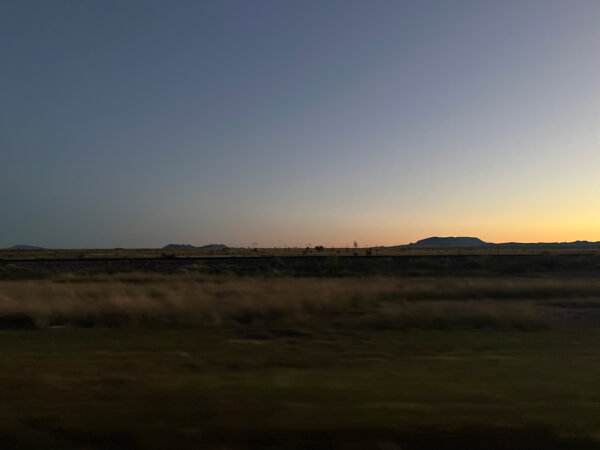The first time I traveled to Marfa was not for Chinati Weekend. Though I was aware of the event, as a college student I wasn’t interested in attending. Even twenty years ago, I thought the idea of an arts community forming “in the middle of nowhere” was problematic, as that mindset inherently ignores longtime residents and leads to gentrification. Instead, on a random weekend, I went on a road trip to see the Marfa Lights. I was fortunate — I spotted them on that first trip and the experience stuck with me. Seeing something that was so unexplainable, and yet had been documented for hundreds of years, made me feel connected to the past and reminded me of all that we, as humans, can never truly know. Those lights, dancing on the horizon, captivated me, as they have thousands of others. But the truth is, I’ve always been enamored with light.
My earliest memory is of a four-year-old me helping my mother wipe down the kitchen table. More than the action or the exact visual memory of the event, I recall the warmth of the golden sunlight streaming through the window blinds. Perhaps this strong memory is why I was drawn to photography, and specifically to recording (or, documenting) the world around me. I took my first photography class in 8th grade and have been chronicling the everyday moments of my life ever since. Over the course of the last 27 years, I have spent much of my time noticing, considering, and capturing light.
Last year was my first time experiencing Chinati Weekend, and it was filled with mixed emotions. It was exciting to see the small town, which I had visited a few times previously, bustling with creative energy. And simultaneously it was difficult to grapple with the reality of what Donald Judd and the subsequent art scene has done to the town — specifically the inflated real estate costs, which have slowly been displacing longtime residents, many of whom are Latino. Additionally, this time last year my grandmother’s health was declining, and I cut my Marfa trip short to be with her and my family. It was a stressful time. So, returning to Chinati Weekend this year brought up an equally tumultuous combination of thoughts and feelings. I was, however, certain of one thing: this year, I would stay through Sunday and make it to the morning viewing of Robert Irwin’s building-sized artwork, untitled (dawn to dusk).
I stayed the weekend in nearby Alpine, which is a little less than a 30-minute drive from Marfa. To make it to the 8 a.m. viewing (the artwork is only open on select days, around the times of sunrise and sunset), I was on the road by 7:15 a.m. The drive was a prequel for the main event and illustrated why this West Texas desert is the perfect location for Irwin’s site-specific piece.
During that time in the car, I watched a transformation: the deep, dark, star-filled sky slowly, and then rapidly, turned into a colorful morning. As I set out, a small strip of orange and yellow light peeked over the horizon, illuminating the lowest part of the sky, while the rest remained inky. As I drove, looking back through the rear window of the car, the silhouetted mountain peaks of Alpine hid the warm orange light, revealing a soft yellow-to-blue gradient. Throughout the drive, the morning stars slowly disappeared, outshone by the increased sunlight. I wondered if the sunrise was always this beautiful, even when hidden by buildings, highways, and other city distractions, or if there was something else at play that brings the sky to life in and around Marfa. By the time I arrived at Chinati, much of the darkness had dissipated, leaving a faded denim-colored sky with hints of orange, yellow, pink, and purple growing in the horizon.
On one level, I knew exactly what Irwin’s piece was — a U-shaped building with windows on each of the exterior walls (which were perfectly facing east and west) that would let in light as the sun rose. But, knowing about it did not prepare me for the experience. Before entering the building, a Chinati staff member explained that half of the building was painted with dark walls and had dark scrims (slightly opaque, gauze-like cloths, a staple of Irwin’s artworks) installed in the hallways, while the other half was painted white and had white scrims. They explained that we could enter either the dark or light building first, and that the two met in the middle.

Robert Irwin, “Untitled (Dawn to Dusk),” mixed-media model, 2014. Photo: Daniel Terna, courtesy of Pratt Institute.
My intuition was that entering the dark half, the east side of the building, would provide the best experience, as it offered contrast to the light streaming into the windows. What I didn’t expect was the way the scrims affected the quality of the light. I went into the dark building and was essentially alone — I was one of the first people to enter the installation.
I began walking between the scrim, which bisected the hallway, and the back wall of the contradictingly dark but light-filled building. Looking down the hallway, I was struck by the various shades of light I could see all at once. Through the scrims and the windows beyond them, I saw the blue sky. On the scrims themselves, the light created orange and pink rectangles. At the end of the hallway, a bright white light emitted from a window and was reflected onto the floor. On the back wall of the space I could see blue light in the recesses of window cubbies; golden yellow rectangles were being projected onto the wall. I stood still, took a deep breath, and let a feeling of calm and balance wash over me.
For a moment, the space was serene, and then a small crowd began to seep into the hallway. I watched as people walked on the light-facing side of the scrim, their forms interrupting the light and casting shadows across the scrim and wall. I tried to keep my focus on the light and how it shifted as I made my way to the midpoint of the building, where the interior of the building changed from black to white. Looking down the west hallway, which was divided by white scrims, was a different experience. The light was less dramatic, but still beautiful. The colored light streaming in through the windows and onto the scrims seemed simply white, but the sky, seen through both the scrim and the windows, had a soft glow. Beyond their role in diffusing the light, the scrims also created new spaces within the building, allowing even a hallway filled with people to have moments of solitude.

A watercolor sketch I made illustrating the wide range of tones you can see in Robert Irwin’s “untitled (dawn to dusk).” Photographs of the space don’t capture the nuance of the light seen in person.
As I stood inside untitled (dawn to dusk), I thought about the light that comes through the windows of my home. It’s something I take note of at various times each day — how the light hits the trees outside the windows and streams through the sheer curtains to whirl and sway and create ephemeral vignettes on the walls, floors, and across the furniture. It struck me that these moments are tiny timestamps, or sundials, tracing minutes, hours, days, months, seasons, the passage of time, and the distance between the past, present, and future. In that instance I was drawn back to memories of my grandmother, of the life she lived, of the moments that made up her nearly 99 years of existence. Suddenly, Irwin’s work encompassed so much more than that singular moment and place, an early Sunday morning in West Texas. It was light and dark; it was time and distance; it was life and death; and all of these things were converging and departing, growing slowly, shifting gradually, and transforming the space and the people inhabiting it.







1 comment
Lovely writing, Jessica! Appreciate your observations, careful thinking, and care with language.